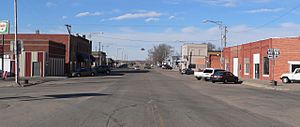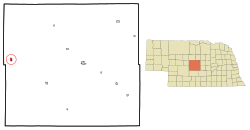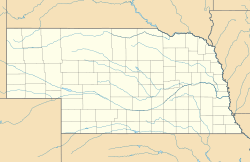Arnold, Nebraska facts for kids
Quick facts for kids
Arnold, Nebraska
|
|
|---|---|
|
Village
|
|

Downtown Arnold: looking west along Arnold Avenue (Nebraska Highway 92)
|
|

Location of Arnold, Nebraska
|
|
| Country | United States |
| State | Nebraska |
| County | Custer |
| Township | Arnold |
| Area | |
| • Total | 0.67 sq mi (1.73 km2) |
| • Land | 0.67 sq mi (1.73 km2) |
| • Water | 0.00 sq mi (0.00 km2) |
| Elevation | 2,704 ft (824 m) |
| Population
(2020)
|
|
| • Total | 592 |
| • Density | 883.58/sq mi (341.30/km2) |
| Time zone | UTC-6 (Central (CST)) |
| • Summer (DST) | UTC-5 (CDT) |
| ZIP code |
69120
|
| Area code(s) | 308 |
| FIPS code | 31-02095 |
| GNIS feature ID | 2397989 |
Arnold is a small village located in Custer County, Nebraska, in the United States. In 2020, about 592 people lived there. The village got its name from an early settler named George Arnold.
Contents
History of Arnold
Arnold was planned and mapped out in 1883. People hoped a railroad would soon reach the area. But the railroad didn't arrive as expected. So, Arnold grew slowly for a while. Finally, in 1912, the railroad came. This helped the village grow much more.
Geography and Location
Arnold covers a total area of about 1.73 square kilometers (or 0.67 square miles). All of this area is land. It is located in the state of Nebraska.
Climate in Arnold
Arnold has a type of climate called a hot-summer humid continental climate. This means it has warm, humid summers and cold winters.
The hottest temperature ever recorded in Arnold was 41 degrees Celsius (106 degrees Fahrenheit). This happened on June 21, 1988, and again on July 20, 2006. The coldest temperature recorded was -35 degrees Celsius (-31 degrees Fahrenheit) on December 22, 1989.
| Climate data for Arnold, Nebraska, 1991–2020 normals, extremes 1967–present | |||||||||||||
|---|---|---|---|---|---|---|---|---|---|---|---|---|---|
| Month | Jan | Feb | Mar | Apr | May | Jun | Jul | Aug | Sep | Oct | Nov | Dec | Year |
| Record high °F (°C) | 73 (23) |
76 (24) |
89 (32) |
95 (35) |
99 (37) |
106 (41) |
106 (41) |
105 (41) |
101 (38) |
93 (34) |
84 (29) |
73 (23) |
106 (41) |
| Mean maximum °F (°C) | 60.2 (15.7) |
64.0 (17.8) |
76.9 (24.9) |
83.6 (28.7) |
89.8 (32.1) |
93.9 (34.4) |
98.1 (36.7) |
96.8 (36.0) |
93.0 (33.9) |
86.7 (30.4) |
73.0 (22.8) |
62.3 (16.8) |
99.7 (37.6) |
| Mean daily maximum °F (°C) | 35.5 (1.9) |
38.3 (3.5) |
50.0 (10.0) |
58.5 (14.7) |
68.0 (20.0) |
78.8 (26.0) |
84.9 (29.4) |
82.4 (28.0) |
75.6 (24.2) |
61.6 (16.4) |
47.7 (8.7) |
36.9 (2.7) |
59.9 (15.5) |
| Daily mean °F (°C) | 24.1 (−4.4) |
26.9 (−2.8) |
37.1 (2.8) |
46.2 (7.9) |
56.8 (13.8) |
67.9 (19.9) |
73.4 (23.0) |
70.6 (21.4) |
62.1 (16.7) |
48.5 (9.2) |
35.4 (1.9) |
25.7 (−3.5) |
47.9 (8.8) |
| Mean daily minimum °F (°C) | 12.7 (−10.7) |
15.6 (−9.1) |
24.1 (−4.4) |
34.0 (1.1) |
45.7 (7.6) |
57.0 (13.9) |
62.0 (16.7) |
58.8 (14.9) |
48.6 (9.2) |
35.4 (1.9) |
23.1 (−4.9) |
14.6 (−9.7) |
36.0 (2.2) |
| Mean minimum °F (°C) | −10.2 (−23.4) |
−5.5 (−20.8) |
2.0 (−16.7) |
18.1 (−7.7) |
29.2 (−1.6) |
43.6 (6.4) |
48.8 (9.3) |
45.9 (7.7) |
32.8 (0.4) |
17.4 (−8.1) |
4.6 (−15.2) |
−4.8 (−20.4) |
−15.5 (−26.4) |
| Record low °F (°C) | −30 (−34) |
−25 (−32) |
−19 (−28) |
9 (−13) |
20 (−7) |
34 (1) |
40 (4) |
37 (3) |
21 (−6) |
7 (−14) |
−15 (−26) |
−31 (−35) |
−31 (−35) |
| Average precipitation inches (mm) | 0.35 (8.9) |
0.62 (16) |
1.17 (30) |
2.47 (63) |
3.73 (95) |
4.06 (103) |
3.47 (88) |
2.60 (66) |
1.83 (46) |
1.88 (48) |
0.72 (18) |
0.62 (16) |
23.52 (597.9) |
| Average snowfall inches (cm) | 5.4 (14) |
7.2 (18) |
4.2 (11) |
2.7 (6.9) |
0.4 (1.0) |
0.0 (0.0) |
0.0 (0.0) |
0.0 (0.0) |
0.0 (0.0) |
1.2 (3.0) |
3.6 (9.1) |
6.1 (15) |
30.8 (78) |
| Average precipitation days (≥ 0.01 in) | 2.8 | 4.0 | 4.7 | 6.7 | 8.5 | 9.4 | 8.0 | 6.1 | 4.9 | 5.4 | 3.4 | 2.5 | 66.4 |
| Average snowy days (≥ 0.1 in) | 2.4 | 3.1 | 2.1 | 0.8 | 0.1 | 0.0 | 0.0 | 0.0 | 0.0 | 0.7 | 1.6 | 2.3 | 13.1 |
| Source 1: NOAA | |||||||||||||
| Source 2: National Weather Service | |||||||||||||
Population of Arnold
The population of Arnold has changed over the years. Here's a look at how many people have lived there during different census years:
| Historical population | |||
|---|---|---|---|
| Census | Pop. | %± | |
| 1910 | 231 | — | |
| 1920 | 933 | 303.9% | |
| 1930 | 899 | −3.6% | |
| 1940 | 884 | −1.7% | |
| 1950 | 936 | 5.9% | |
| 1960 | 844 | −9.8% | |
| 1970 | 752 | −10.9% | |
| 1980 | 813 | 8.1% | |
| 1990 | 679 | −16.5% | |
| 2000 | 630 | −7.2% | |
| 2010 | 597 | −5.2% | |
| 2020 | 592 | −0.8% | |
| U.S. Decennial Census | |||
Arnold in 2010
In 2010, the village of Arnold had 597 people living in 295 households. About 166 of these households were families. The population density was about 341 people per square kilometer (891 people per square mile).
Most of the people living in Arnold (98.5%) were White. A small number were African American (0.2%) or from other backgrounds. About 1.8% of the population identified as Hispanic or Latino.
- About 20% of households had children under 18 living with them.
- Nearly half (47.8%) of households were married couples.
- About 41% of all households were made up of people living alone.
- About 21.7% of households had someone aged 65 or older living alone.
The average age of people in Arnold was about 48.3 years old.
- About 19.9% of residents were under 18.
- About 26.3% were 65 years or older.
- The population was almost evenly split between males (49.1%) and females (50.9%).
See also
 In Spanish: Arnold (Nebraska) para niños
In Spanish: Arnold (Nebraska) para niños



